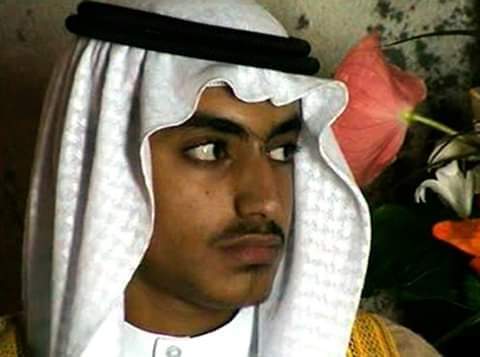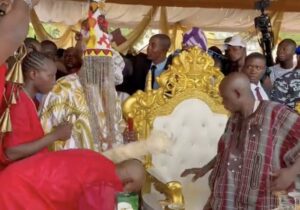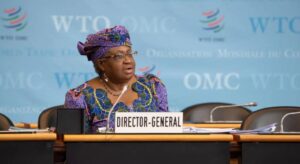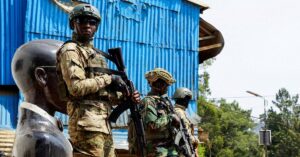
Osama bin Laden’s son Hamza bin Laden, who was viewed as an eventual heir to the leadership of Al Qaeda and had repeatedly threatened to attack the United States, is dead, according to two American officials.
Details of the strike that killed him were scarce, including when and where. The United States government played a role in the operation, but it was not clear how, according to the officials, who discussed his death on the condition of anonymity because it involved sensitive operations and intelligence gathering.
Mr. bin Laden was killed sometime during the first two years of the Trump administration, officials said. He was killed before the State Department announced a $1 million reward for information about his whereabouts in February, but American military and intelligence agencies had not confirmed his death by then.
Though Mr. bin Laden carried a prominent name and lineage, the news of his death represented more of a symbolic victory for the American government than the removal of a threat. Al Qaeda has not carried out a large-scale attack in years, and though Mr. bin Laden was being groomed to eventually take over the group, that time appeared to be well into the future.
Ali Soufan, a former F.B.I. agent who investigated and has written extensively about Al Qaeda, including a lengthy profile of Hamza bin Laden published in 2017, sounded a note of caution because it is unusual for Al Qaeda not to announce the death of a leader and celebrate him as a martyr. But if the American government’s assessment is accurate, he said, “it significantly damages Al Qaeda’s plans for moving to the second generation.”
Unlike other Qaeda leaders, Mr. bin Laden never criticized the Islamic State in his public speeches, Mr. Soufan noted. The tactic suggests that he was holding back so members of the Islamic State, which began as a Qaeda affiliate and shares its ideology but broke away from its control, might have eventually accepted him as leader in any future reunification.
After the 2011 death of Osama bin Laden in a SEAL Team 6 raid in Abbottabad, Pakistan, two of his top lieutenants began preparing Hamza bin Laden for a top leadership role. He married a daughter of one of them and pledged to avenge his father’s death.
Mr. bin Laden was introduced as a voice of Al Qaeda in August 2015 as “a young lion to carry forth the cause.” The regular messages that Al Qaeda released from Mr. bin Laden stopped months ago, although an article attributed to him was published in May.
Al Qaeda distributed a letter in December 2017, dated from the previous summer, in which Hamza bin Laden said his 12-year-old son had been killed, according to the SITE Intelligence Group, which tracks terrorist organizations. The letter did not talk about the circumstances of the death, but made reference to martyrdom, suggesting the boy may have been killed in a strike targeting his father.
Mr. bin Laden was likely operating on the Pakistan-Afghanistan border, said Thomas Joscelyn, a senior fellow at the Foundation for Defense of Democracies.
While Mr. Joscelyn said he doubted that Mr. bin Laden was next in line to lead Al Qaeda, he said he had an important role, both in terms of ties to the Taliban and as a spokesman.
“They were building him up to potentially be the No. 1 someday; he was not thought of as the heir apparent today,” Mr. Joscelyn said.
Omar bin Laden, another son of the Qaeda founder, has maintained that the group had used Hamza bin Laden for his name and potentially manipulated him into becoming its face, said Jean Sasson, the co-author of “Growing up bin Laden.”
President Trump was asked on Wednesday about the death, first reported by NBC News, but he declined to comment.
The location of Mr. bin Laden had been the subject of public speculation. After the Sept. 11 attacks, he and other members of Al Qaeda fled to Iran, where they were detained. He was eventually allowed to leave Iran, then reportedly moved with his family to the Pakistan border region. At one point, intelligence showed that he had traveled to Syria in the past several years, former officials have said.
The C.I.A. has devastated Al Qaeda, relentlessly targeting its operatives after Sept. 11. The agency killed another son, Saad bin Laden, in a drone strike in 2009 while he was operating in a remote area of Pakistan. Another son, Khalid, was killed in the 2011 Abbottabad raid.
The C.I.A. continues to hunt for Ayman al-Zawahri, who assumed the Qaeda leadership mantle after Osama bin Laden’s death. Former intelligence officials said the agency undertook a sophisticated effort in 2012 and 2013 to determine whether he was living in a village in Pakistan’s troubled North Waziristan region. Agency operatives had high confidence they had found Mr. al-Zawahri but were never able to identify his exact location within the village, one former official said.
Mr. bin Laden appears to have worked closely with Mr. al-Zawahri, especially in maintaining ties to the Taliban in Afghanistan and shaping the organization’s message.
“If in fact he is dead, this makes the ranks of Al Qaeda’s senior leadership that much thinner and the connection to Osama bin Laden even more attenuated,” said Nicholas J. Rasmussen, a former director of the National Counterterrorism Center.
Even had he taken over for his father to lead Al Qaeda, Hamza bin Laden would have faced challenges as an untested leader. But his famous name would have been a boon to the terrorist organization.
“This hurts the Al Qaeda brand,” said Colin P. Clarke, a senior fellow at the Soufan Center, a research organization for global security issues. “Even though he was unproven and untested, that name still means a lot to young jihadis.”
Other key members of the organization remain alive, including Saif al-Adel and Abdullah Ahmed Abdullah, who are wanted by the F.B.I. in the bombings of two United States embassies in East Africa in 1998. They are thought to be in Iran.
Mr. bin Laden’s time in Iranian custody has been the subject of controversy, and the presence of Qaeda members in Iran prompted questions about what the Iranian government was doing with them. Iran is dominated by Shiite Muslims, whom the hard-line Sunnis of Al Qaeda see as heretics.
At times when the Qaeda officials were out of detention, Iran allowed them to stay to ward off potential attacks from Al Qaeda, said Bruce Hoffman, a professor at Georgetown University and a terrorism expert. Both Iran and Al Qaeda also have the United States as a common enemy.
“It’s a marriage of convenience,” Mr. Hoffman said. Anything that Iran can do to “keep the United States off balance,” he said, “they’ll do it.”
Secretary of State Mike Pompeo and other American officials have stressed ties between Al Qaeda and Iran in recent briefings to Congress. Concerned members of Congress from both parties have said administration officials are trying to lay the legal groundwork for potential military action against Iran by arguing that the 2001 authorization of war against Al Qaeda or any of its allies would allow the United States to attack Iran.







